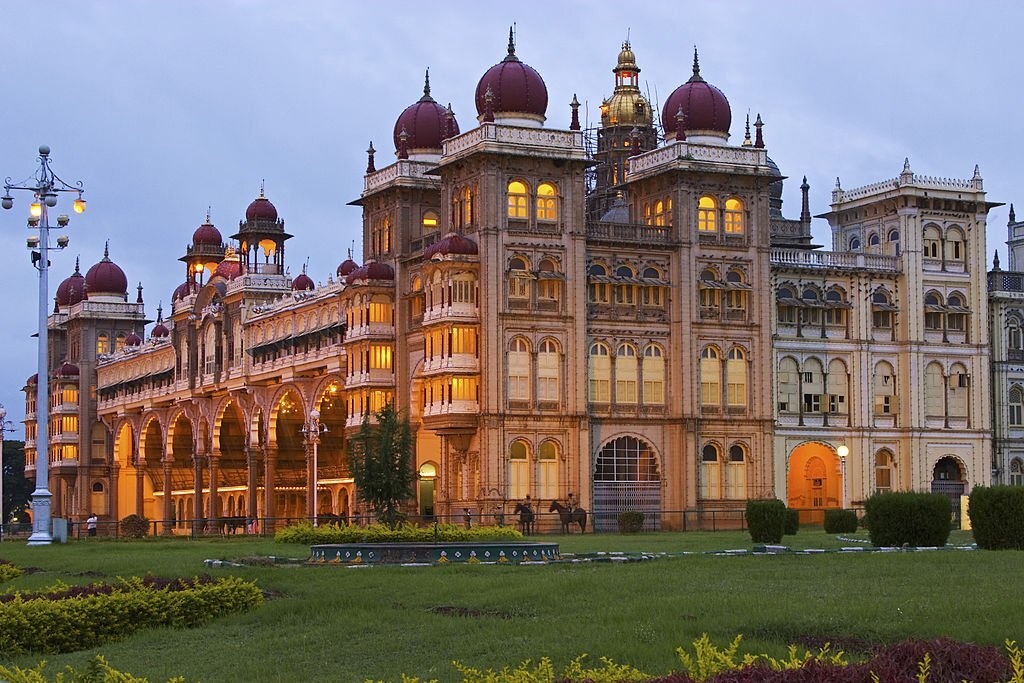One of the most stunning and expansive palaces in India is the Mysore Palace, commonly referred to as Amba Vilas Palace and Mysore Aramane. It was formerly the official seat of the Wodeyar Dynasty, who ruled Mysore from 1399 to 1950, and is located in the southern state of Karnataka. The majestic palace, which commands prominence in the centre of Mysore City, draws tourists from all over the world. Given that it ranks second only to the Taj Mahal among India’s top attractions, it merits a spot on every traveler’s must-see list. So why not pay a visit to Mysore Palace over the holidays?
Information about Mysore Palace:
Location: Road Sayyaji Rao
Timings: 10 a.m. to 5:30 p.m.; daily entrance fee 70 for adults; 30 for children aged 7 to 12 years.
Video and still camerasNot permitted within the palace
closest train station(2 miles) from Mysore Junction
Additional Names: Mysuru Palace, Amba Vilas Palace, and Mysore Aramane
Year of Inception: commissioned in 1912 by Maharaja Krishnaraja Wodeyar IV and Maharani Kempananjammanni Devi
Architect: John Irwin
Building Design: Indo-Saracenic
Status : a palace under the control of the Karnataka government that serves as the Wadiyar Dynasty’s official residence
Construction Cost: 41,475,000 (as of 1912)
Size of the main complex : Dimensions of the gold-plated dome include 245 feet in length, 156 feet in width, and 145 feet in height.
Ideal Season to Visit: During the Dasara festival
History of the Mysore Palace
This regal building is the most magnificent of the seven palaces that line the streets of Mysore. The royal family of Mysore, the Wodeyars or Wadiyars, built the palace’s foundation centuries ago. A palace in Puragiri, also known as the Old Fort, is thought to have been constructed during the time of Yaduraya Wodeyar, the first king of the Mysore Kingdom. Over the course of six centuries, this palace, which is thought to be the forerunner of the present palace, has been repeatedly destroyed and rebuilt.
The palace was originally a wooden stronghold that was rebuilt during the rule of Kantirava Narasa Raja Wodeyar after being struck by lightning in 1638. When Tipu Sultan seized control of the Wodeyar Dynasty in 1793 A.D., he destroyed the palace and rebuilt it. After Tipu Sultan’s death in 1799, Krishnaraja Wodeyar III took control of the palace and renovated it in the Hindu architectural style.
Architecture of the Mysore Palace
Mysore Palace was constructed in the Indo-Saracenic architectural style with elements of Hindu, Mughal, Rajput, and Gothic design. Fine grey granite was utilised to construct the three-story palace and a 145-foot, five-story tower, while deep pink marble was used to construct the domes. Two durbar halls, numerous arches, canopies, columns, and bay windows decorate this magnificent building’s facade. The palace is surrounded by a huge landscape of greenery. The interiors feature stunning Czechoslovakian chandeliers, carved doors, stained glass ceilings, sparkling glazed flooring tiles, and artwork from all around the world. The mansion has incredibly lavish and enticing interiors in every room.
Gajalakshmi, the goddess of riches, is shown in a heavenly sculpture with two elephants above the main arch. The palace has additional hidden tunnels in addition to the three entrances, which are situated on the eastern, southern, and western sides. The palace also contains a collection of temples that date from the 14th to the 20th century.
Today’s Mysore Palace
Mysore Palace is still known as the Royal Seat of the Maharajas of Mysore and is currently run by the Government of Karnataka. The magnificent structure protects numerous priceless relics of the Wodeyars, including trinkets, jewellery, regal attire, and paintings. Even though the palace is accessible to the general public, the former royal family still resides in a portion of it. A portion of these residences are included in the Residential Museum, a museum that is housed within the walled complex. It is not surprising that the palace is one of Mysore’s most important historical sites.
- The Golden Howdah, the Maharaja’s elephant seat composed of 85 kilogrammes of gold, and the Gombe Thotti or Doll’s Pavillion, a collection of traditional dolls
- A hall with an octogonal shape and a stained glass ceiling is called the Kalyana Mantap or Marriage Pavillion.
- Large hall known as Public Durbar Hall, where the Maharajas once addressed the populace
- The Maharajas used Ambavilasa, a finely constructed room, for their private audiences.
- Portrait Gallery, a collection of priceless royal family portraits and paintings
- the royal collections-containing Casket Room
- Battleground Courtyard
- Internal temples of the palace
- The Light and Sound Show at Mysore Palace
One of the main draws at Mysore Palace is the nighttime light and sound extravaganza. The entire production presents the Wodeyar Dynasty’s 600-year cultural legacy, history, and traditions in a visually pleasing way.
Duration: 30 minutes
Timings: 7 p.m. to 8 p.m., every day excluding Sundays and public holidays.
A ticket: 70 for adults; 30 for children aged 7 to 12 years old.
Mysore Palace Lighting
During the 10 days of Dasara celebrations, as well as on Sundays and other holidays, Mysore Palace is illuminated in the evening. The illumination lasts for five minutes on weekdays after the light and sound display. The palace is a sight to behold because to the 97,000 electric bulbs used for illumination.
Timings:
7:00 pm to 7:45 pm on Sundays, public holidays, and during Dasara
7:40 p.m. to 7:45 p.m. on weekdays
